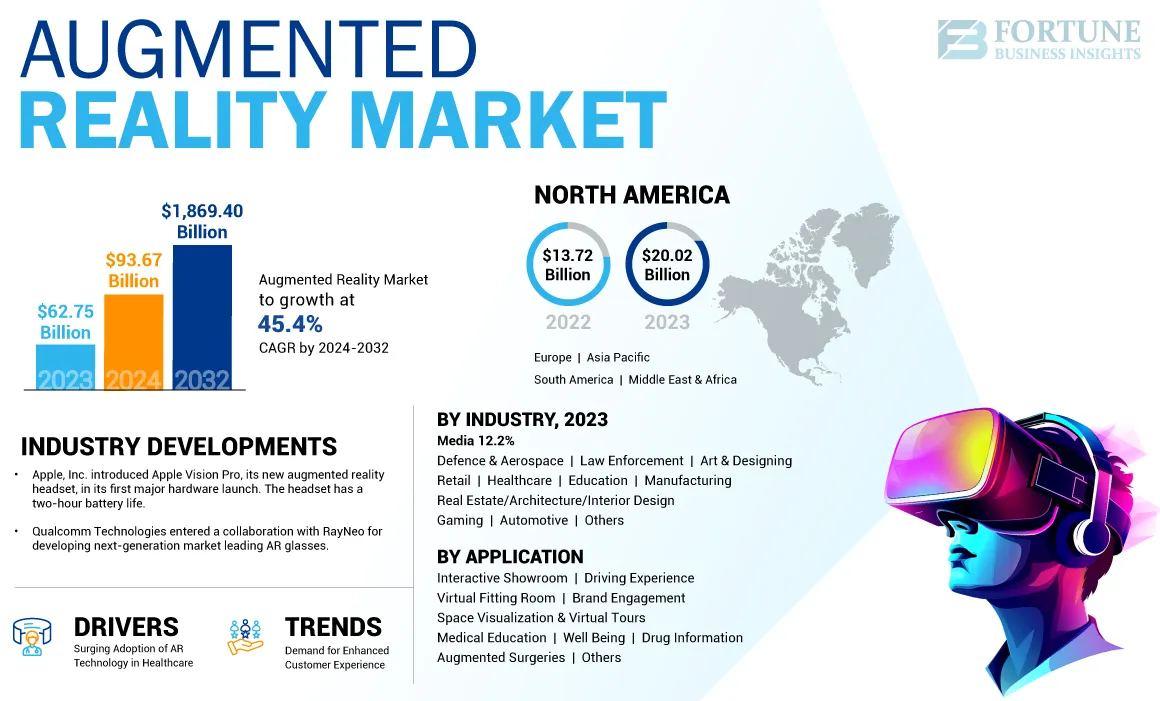Augmented Reality Market Size & Trends
The global augmented reality market size was estimated at USD 83.65 billion in 2024 and is expected to grow at a CAGR of 37.9% from 2025 to 2030.
The market growth is primarily driven by technological advancements in AR hardware and software. Enhanced processing power, better graphics, and AI integration have enabled more realistic and immersive AR experiences. Companies leverage AR for virtual try-ons, 3D mapping, and interactive gaming, driving adoption across industries.
Industry Adoption of AR
Retail and E-commerce
Retail and e-commerce industries increasingly adopt AR to enhance customer experiences. Virtual product try-ons, furniture previews, and visualization of items in real-world settings boost consumer engagement and sales.
Healthcare
AR is expanding in medical training, surgical visualization, and patient care, enhancing precision and effectiveness. Companies develop AR tools for complex surgeries and medical training, significantly boosting demand.
Mobile Devices
The prevalence of AR-capable mobile devices transforms consumer interaction with digital content. Mobile AR applications create personalized, real-time experiences, enhancing consumer satisfaction.
Collaborations and Partnerships
Increasing collaborations between technology providers and industries foster AR innovation. Partnerships in education enhance immersive learning, while retail collaborations revolutionize customer engagement.
Component Insights
Hardware Segment
The hardware segment accounted for over 58% market share in 2024, driven by AR headsets, smart glasses, and displays adoption in education, gaming, entertainment, and manufacturing. High-quality AR hardware demand in gaming, aerospace, and defense significantly contributes to growth.
Software Segment
The software segment is expected to witness the fastest CAGR from 2025 to 2030, driven by AR applications enhancing user experiences in retail and education. Cloud-based AR solutions and enterprise applications for workflow optimization and remote collaboration fuel software growth.
Display Insights
Head-Mounted Displays (HMDs)
The head-mounted segment dominated the market in 2024, widely adopted in education, defense, and manufacturing. HMDs are essential for immersive training, simulations, and real-time problem-solving, especially in hands-free operations.
Smart Glasses
The smart glasses segment is expected to witness the fastest CAGR from 2025 to 2030, driven by enterprise applications in logistics, manufacturing, and education. Smart glasses enable real-time data overlay, remote collaboration, and consumer applications like navigation and fitness tracking.
Application Insights
Industrial & Manufacturing
The industrial & manufacturing segment dominated in 2024, driven by AR applications enhancing productivity, training, and operational efficiency. Real-time equipment maintenance, remote assistance, and assembly line monitoring reduce downtime and improve performance.
Healthcare
The healthcare segment is anticipated to record the fastest growth from 2025 to 2030, driven by AR integration in medical training, diagnostics, and surgery. AR aids advanced surgical visualization, immersive medical education, telemedicine, and patient engagement.
Regional Insights
North America
North America accounted for over 33% revenue share in 2024, driven by technological advancements, AR startups, and significant R&D investments. Industries like gaming, retail, and education increasingly utilize AR.
Europe
Europe's AR market growth is driven by demand from gaming, education, and manufacturing sectors. Germany, France, and the UK leverage AR for operational efficiency and product design. The UK's vibrant startup ecosystem fosters AR innovation.
Asia Pacific
Asia Pacific is expected to grow at the highest CAGR of over 41% from 2025 to 2030, driven by digital transformation, smartphone usage, and government initiatives promoting AR in education and retail. Japan and China significantly contribute to regional growth.
Key Companies in AR Market
- Apple, Inc.: Integrates AR in devices like iPhones, iPads, and Vision Pro headset via ARKit, focusing on seamless user experiences.
- Google LLC: Offers ARCore platform, enhancing user engagement across sectors like retail and education.
- Lenovo Group: Develops AR solutions for enterprise applications through ThinkReality platform and smart glasses.
- Snap, Inc.: Focuses on consumer-driven AR experiences through Snapchat lenses and Spectacles smart glasses, enhancing user engagement and advertising.
